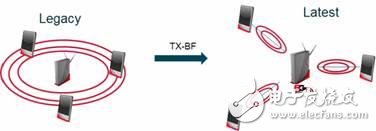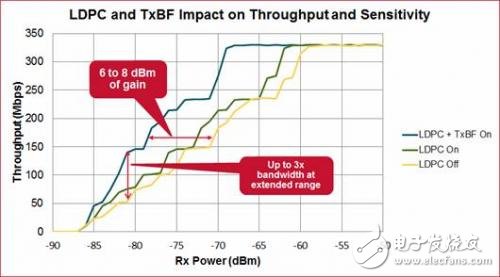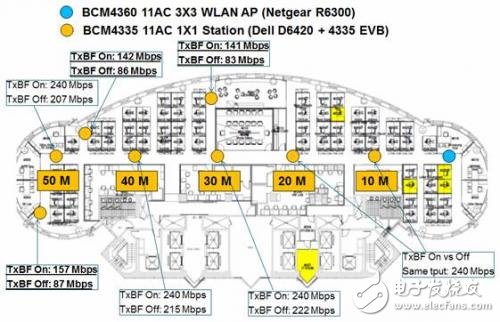Wi-Fi enabled devices are everywhere. Researchers predict that by 2020, the number of wireless interconnect devices worldwide will rise to 50 billion units. Therefore, consumers not only want to enjoy rich multimedia content on different devices such as computers, tablets, smart phones, TVs and game consoles, but also hope to improve the running speed, reliability and power efficiency of the devices. Fortunately, the 802.11ac standard, or the fifth generation of Wi-Fi (5G WiFi) technology has emerged as the key to the next step, which can help the wireless communications industry meet these needs. Compared to previous Wi-Fi technologies, 5G WiFi is faster and more efficient at transmitting gigabit throughput. At the same time, when running on a 5 GHz bandwidth, it supports backward compatibility as with other 802.11 technologies on the same bandwidth. In addition, through a combination of technologies such as transmission (Tx) beamforming and low-density parity check (LDPC), it is expected to solve the problem of "limited coverage and connection speed (eg, rate)" and more and more plagued Wi-Fi. Puzzle. To better understand this problem, let's take the example of a typical WLAN setup in a home environment that connects to different devices (such as smartphones, tablets, laptops, printers, and TVs) via a wireless router. Because the floors and walls in the home may also form part of the connected scene, not all locations in the home can achieve the best connection. Most consumers intuitively take action to improve connectivity, for example, opening the door to improve the signalling effect of a WLAN access point (AP) installed in a family room. Since it is not realistic to change the AP location in the home frequently, we need to take other measures to improve the connection. 5G WiFi uses two optional technologies to accelerate connection performance by increasing the rate or throughput within a limited range. Among them, the most effective method is beamforming technology, which is a non-patent technology that can be applied to a variety of devices and can improve the wireless connection performance by 2-3 times. Beamforming technology can control the direction of RF energy and direct it to the receiver that is intended to receive the signal, thereby improving wireless connectivity (Figure 1). This technology even allows wireless signals to bypass the corners or through walls, eliminating the blind spots of Wi-Fi networks. Figure 1. With 802.11ac (and 802.11n) beamforming technology, hubs or APs can route wireless signals directly to devices that require signals, no matter how many devices are in the vicinity. In contrast, conventional Wi-Fi technology can only radiate wireless signals in a set area, and any device in the area can receive the signal. LDPC is a forward error correction coding system that is often used to ensure coding reliability and increase coding gain. The method was invented in the early 1960s and can transmit information at frequencies where background noise is high and data is susceptible to damage. Using this method, we can significantly reduce the probability of loss of information transmission in the noise channel, thus ensuring efficient and reliable transmission of information, while also gradually increasing the transmission rate over a larger range. When beamforming and LDPC technology are used in combination, it can increase overall wireless coverage and speed and expand its range of connections relative to the 802.11ac 256 QAM standard. In fact, the gain can be increased by 6 to 8 dBm and the bandwidth boost can be extended by up to 3 times (Figure 2). In addition, in addition to the optional 160MHz channel or non-contiguous 80+80MHz channel, 5G WiFi also supports 80-MHz channels, which means there will be more high-speed lines to support increased traffic. In other words, 5G WiFi can increase bandwidth by up to 4 times by using a 160-MHz frequency on an 80-MHz channel. These practices do improve performance significantly, so what is the real value for end users? To answer this question, we might as well imagine such a typical corporate scenario. For example, office space is located on different floors and has different office spaces such as offices and cubicles (Figure 3). A 5G WiFi 3x3 WLAN AP and several 5G WiFi stations are located around the office facilities to provide wireless connectivity to employees. We use different distances from the AP to detect the throughput when using beamforming technology. When the distance is 10 meters and 20 meters, the throughput will remain unchanged whether or not beamforming technology is used. When the distance is 30 meters and 40 meters, we can obviously see the use of beamforming technology to improve the throughput; however, beamforming The biggest effect of the technology is that when the distance reaches 50 meters, the beamforming technology can be used to increase the throughput to 157 Mbps, and the beamforming technology is only 87 Mbps, which means that the throughput is increased by up to 80%. If you use LDPC technology together, you can further improve throughput. Consumers are increasingly demanding more connected devices and data, while enterprise networks must strive to meet the needs of more densely populated users while improving the user experience, so advanced technologies such as beamforming and LDPC are becoming more critical today. By dramatically improving wireless connectivity, we are able to pave the way for traditional Wi-Fi technology to transform 5G WiFi technology and prepare for future growth. Spiral Rotor Flowmeter,marine helical rotor flowmeter,lzx type marine helical rotor flowmeter Taizhou Jiabo Instrument Technology Co., Ltd. , https://www.jbcbyq.com

Figure 2. LDPC and beamforming techniques work together to greatly improve receiver throughput and sensitivity. 
Figure 3. 5G WiFi beamforming technology increases connectivity and data rates for a given client or device. In this case, the technology can increase throughput by up to 80%.